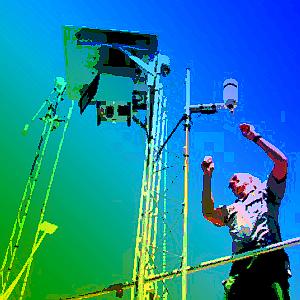The following is a Mar. 12 press announcement from the Mojave Desert Air Quality Management District:

An area is found to have attained the federal 0.12 parts per million standard if there are no violations recorded, based on three consecutive calendar years of complete, quality assured and certified air monitoring data. In their letter to the United States Environmental Protection Agency, CARB requested that the federal agency make a determination that air quality in the region met the standard, based on a review of local ozone data from 2009 to 2012, which showed that the number of days per calendar year with a maximum hourly concentration greater than 0.12 ppm was one day or less.
Preliminary data for 2013 also indicates that no days exceeded the one hour ozone standard in the High Desert.
In sharp contrast 77 days exceeded the standard in 1994. “We are ecstatic that the state has finally recognized the clean air efforts of the High Desert’s businesses and residents,” commented MDAQMD Executive Director Eldon Heaston. “This milestone brings our region one step closer to achieving regulatory equity and insuring that the High Desert is not penalized for pollution it does not create.”
The Federal Clean Air Act requires USEPA to set standards for pollutants which are considered harmful to public health and the environment, such as carbon monoxide and ozone, the primary component of photochemical smog. These standards have been progressively tightened through the years, as health studies and technology have determined that more stringent thresholds are needed to protect asthmatics and other sensitive individuals.
In 1991, a portion of the Southeast Desert Air Basin – which includes the Victor Valley/Barstow region of San Bernardino County located in the MDAQMD – was designated nonattainment for the 0.12 ppm federal standard, based on air monitoring data collected within the basin. Although the 0.12 ppm standard was subsequently revoked in 1997 by the USEPA – which had replaced it with a more stringent eight hour standard – many regions continued to have regulatory obligations under the former standard, based on court challenges to its rescission. Areas within the SEDAB were among these regions, including the MDAQMD.
Meanwhile, the Federal Clean Act required the MDAQMD to reduce its ground-level ozone standards to meet the revoked standard by 2007. When the MDAQMD was unable to meet this mandate – based on monitored ozone levels in the region which are overwhelmingly impacted by windblown pollutants transported into the area from the Los Angeles basin – the USEPA threatened to impose punitive fines on all major emission sources in the region, unless they reduced their emission levels to no more than 80% of 2007 levels. For local cement manufacturer CEMEX, those fines could have been as high as $11.5 million.
In an effort to avert the fines from further devastating the High Desert’s struggling economy, the MDAQMD’s Governing Board adopted a “backstop rule” which aggregated emissions from major facilities in the area and compared them to federal standards, instead of targeting individual facilities. With the High Desert poised to meet the federal one-hour standard, the daunting fines which could have crippled the local economy are no longer looming.
“The High Desert’s air has met a once seemingly unattainable air quality standard,” said MDAQMD Governing Board Chair Barbara Riordan, adding, “It’s a great day for the health of High Desert residents and its economy.”

